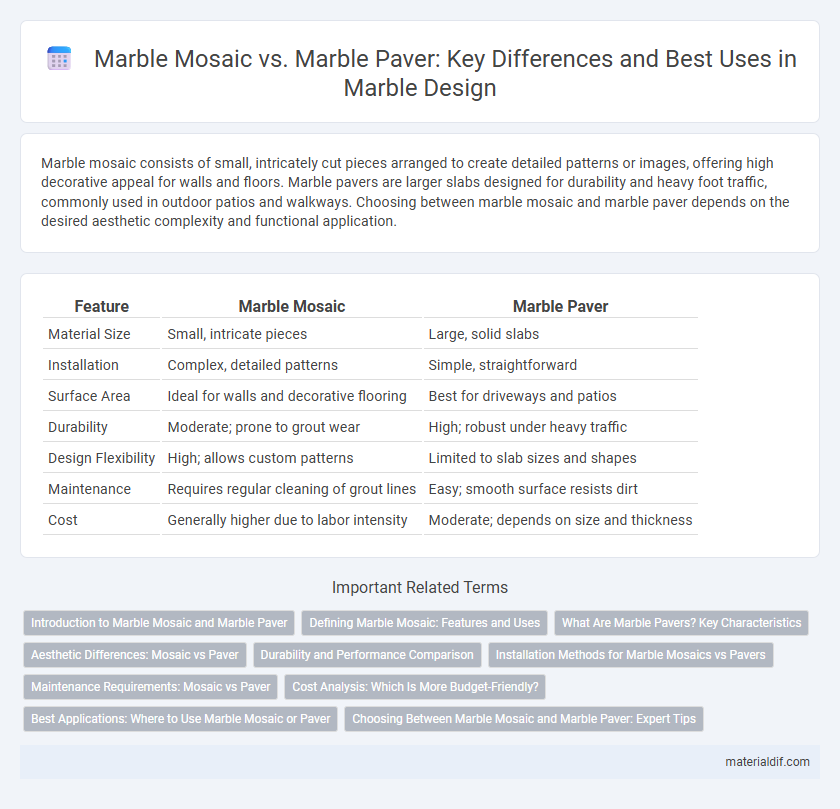Marble mosaic consists of small, intricately cut pieces arranged to create detailed patterns or images, offering high decorative appeal for walls and floors. Marble pavers are larger slabs designed for durability and heavy foot traffic, commonly used in outdoor patios and walkways. Choosing between marble mosaic and marble paver depends on the desired aesthetic complexity and functional application.
Table of Comparison
| Feature | Marble Mosaic | Marble Paver |
|---|---|---|
| Material Size | Small, intricate pieces | Large, solid slabs |
| Installation | Complex, detailed patterns | Simple, straightforward |
| Surface Area | Ideal for walls and decorative flooring | Best for driveways and patios |
| Durability | Moderate; prone to grout wear | High; robust under heavy traffic |
| Design Flexibility | High; allows custom patterns | Limited to slab sizes and shapes |
| Maintenance | Requires regular cleaning of grout lines | Easy; smooth surface resists dirt |
| Cost | Generally higher due to labor intensity | Moderate; depends on size and thickness |
Introduction to Marble Mosaic and Marble Paver
Marble mosaics consist of small, intricately cut pieces of marble arranged to create decorative patterns or images, often used for artistic flooring and wall designs. Marble pavers are larger, thicker slabs designed for durable outdoor surfaces like patios, walkways, and driveways, providing both strength and aesthetic appeal. Both materials showcase natural marble's elegance but serve distinct functional purposes in architecture and design.
Defining Marble Mosaic: Features and Uses
Marble mosaic consists of small, intricately cut pieces of marble arranged in detailed patterns or images, offering a decorative and artistic appeal ideal for wall art, backsplashes, and flooring accents. These mosaics are prized for their versatility in design, durability, and the ability to create sophisticated visual effects in both residential and commercial spaces. Marble pavers, in contrast, are larger slabs used primarily in outdoor paving or heavy-traffic areas, focusing on durability and ease of installation rather than intricate design.
What Are Marble Pavers? Key Characteristics
Marble pavers are thick, durable stone tiles used primarily for outdoor flooring, patios, driveways, and walkways due to their high resistance to weather and heavy foot traffic. These pavers typically measure around 1 to 2 inches in thickness, providing enhanced strength and stability compared to thinner marble mosaics. Key characteristics include a textured surface for slip resistance, natural stone patterns that add aesthetic appeal, and long-lasting durability suitable for both residential and commercial exterior applications.
Aesthetic Differences: Mosaic vs Paver
Marble mosaic offers intricate patterns and vibrant color variations that create visually stunning and detailed surfaces, ideal for artistic and decorative applications. In contrast, marble pavers provide a more uniform appearance with larger, solid slabs that emphasize natural veining and create elegant, spacious flooring or patio designs. The aesthetic distinction lies in mosaics' complexity and texture versus pavers' simplicity and smoothness, each catering to different design preferences and spatial effects.
Durability and Performance Comparison
Marble mosaics, composed of small, intricately arranged tiles, offer moderate durability suitable for low-traffic areas, whereas marble pavers, made from larger, thicker slabs, provide superior strength and resilience ideal for high-traffic and outdoor applications. The dense composition and greater thickness of marble pavers enhance resistance to wear, weather, and heavy loads, outperforming marble mosaics in longevity and structural integrity. Maintenance requirements differ as marble mosaics may require more frequent sealing to protect grout lines, while marble pavers benefit from easier upkeep due to fewer joints and a more robust surface.
Installation Methods for Marble Mosaics vs Pavers
Marble mosaics require precise installation with thin-set mortar applied on a smooth, clean substrate, ensuring small, intricately arranged tiles fit seamlessly for detailed patterns. Marble pavers, being larger and thicker, demand a more robust base preparation, often involving a compacted sand or gravel bed and the use of mortar or concrete for leveling and stability. Proper grouting for mosaics enhances aesthetics and water resistance, while paver joints focus on durability and load-bearing capacity.
Maintenance Requirements: Mosaic vs Paver
Marble mosaics require more meticulous maintenance due to their smaller, intricate pieces and numerous grout lines, which can trap dirt and necessitate frequent cleaning. Marble pavers, with larger surface areas and fewer grout joints, are generally easier to clean and maintain, offering better durability against wear and tear. Both types benefit from regular sealing to protect against stains and moisture, but mosaics demand more frequent attention to preserve their detailed appearance.
Cost Analysis: Which Is More Budget-Friendly?
Marble pavers generally offer a more budget-friendly option compared to marble mosaics due to lower installation and material costs. Marble mosaics involve intricate patterns and smaller pieces, increasing labor expenses and overall project price. For large-scale flooring projects, marble pavers provide cost savings while maintaining the natural elegance of marble surfaces.
Best Applications: Where to Use Marble Mosaic or Paver
Marble mosaics are ideal for intricate indoor designs such as backsplashes, bathroom walls, and decorative flooring due to their smaller size and detailed patterns. Marble pavers are better suited for outdoor applications like patios, walkways, and pool surrounds because of their larger size and durability. Choosing between marble mosaic or paver depends on the project's scale and exposure to weather conditions.
Choosing Between Marble Mosaic and Marble Paver: Expert Tips
Marble mosaics provide intricate design options with smaller, pre-cut pieces ideal for decorative walls and backsplashes, offering a unique, artistic appeal. Marble pavers consist of larger slabs suited for flooring and outdoor patios, valued for their durability and easy maintenance under heavy foot traffic. Experts recommend selecting marble mosaics for detailed aesthetic projects and marble pavers where toughness and functionality are priorities.
Marble Mosaic vs Marble Paver Infographic

 materialdif.com
materialdif.com